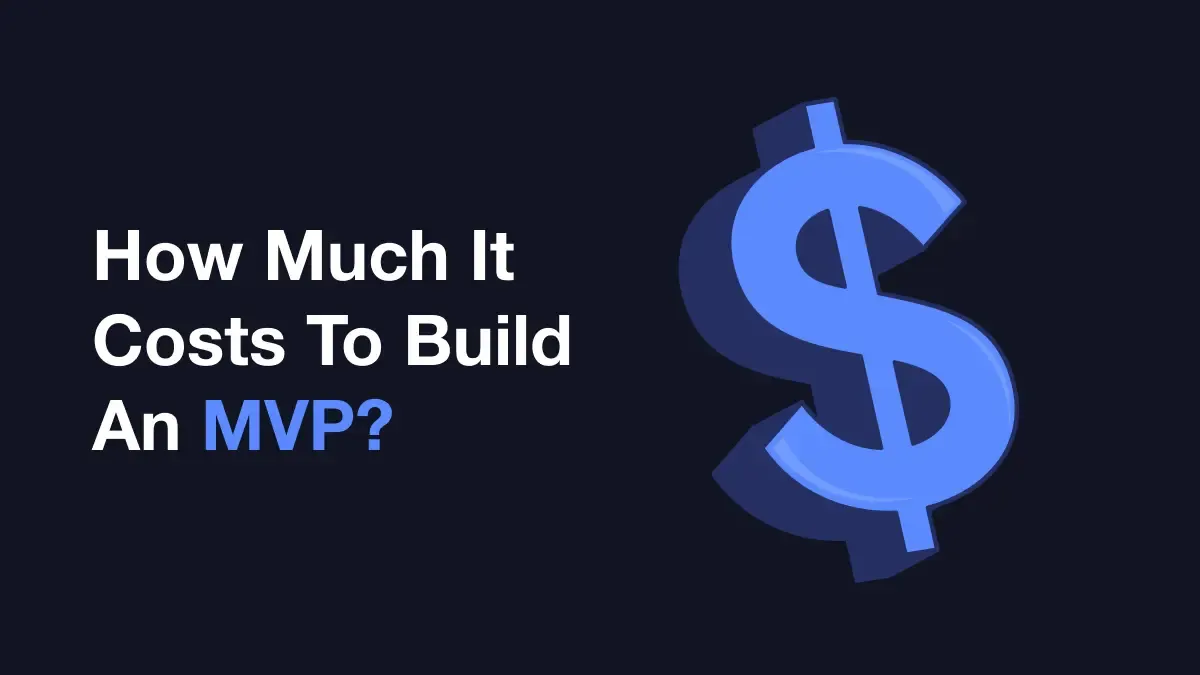EXPLORE
Got a Question? Connect with our experts.
Talk to an Expert
Got a Question? Connect with our experts.
Talk to an Expert
Planning to build an MVP?
One of the first questions you will likely ask yourself is:
“How much will it cost to build an MVP (Minimum Viable Product)?”
The cost of building an MVP can vary significantly based on a range of factors. Like the complexity of the product, the platform you choose, the design, and the team you hire.
Whether you are planning a simple or a more complex application, understanding the costs involved is crucial to managing your budget and launching your MVP successfully.
In this article, we will provide you with a detailed breakdown of the costs associated with developing an MVP.
We'll discuss all the factors that influence the cost of an MVP, such as functionality, third-party integrations, and how to optimize your budget effectively.
Before we start, let’s clarify what an MVP (Minimum Viable Product) is.
What is an MVP?

An MVP is a version of your product that includes only the essential features necessary to solve the core problem for your target audience.
Its primary purpose is to validate your business idea with real users, gather feedback, and refine the product based on that feedback.
Building an MVP allows you to go to market quickly, reduce risk, and save costs in the long run.
Instead of investing large amounts in building a complete product, MVP allows you to test if people are willing to pay for your product fast.
The Key Factors that Will Influence Your MVP Development Costs
How complex is your product?
The complexity of your MVP is the single largest factor influencing the price.
The more advanced the features, the more time and resources are required to build them.
It becomes absolutely necessity to keep the features simple.
What are your MVP’s features and functionality?
To keep costs manageable, focus on the core functionality needed to validate your idea.
Key features that increase the complexity and cost of an MVP include:
- User Authentication and Authorization. e.g., sign-ups, logins, social media logins.
- Payment Gateway Integration. e.g., Stripe, PayPal.
- Geolocation Services. e.g., maps, location tracking.
- Real-Time Data. e.g., chat, notifications, live data updates.
- Admin Dashboard. For content or user management.
By keeping your feature set lean and focusing on just the most essential aspects, you can keep development costs low and minimize risk.
Prioritizing the features that are absolutely necessary to your MVP will prevent unnecessary development time and cost.
How do you decide what features to include in your MVP?
Multiple techniques can help you measure the impact that a feature will have on your core target audience. This helps you decide which features to include in the first version of your MVP.
Some of the feature prioritization frameworks are:
- RICE Framework
- MoSCoW Method
- The Priority Matrix
- Kano Model
- Story Mapping
Simple vs Complex MVP
Simple MVP could be a basic website or a mobile app with only essential features, such as user sign-in/sign-up, core functionality, and a straightforward user interface (UI).
Whereas, more complex MVPs could include features such as real-time data, payment systems, geolocation, multi-platform functionality, advanced security features, or AI algorithms.
| MVP Type | Description | Cost |
|---|---|---|
| Simple MVP | A basic website or a mobile app with only essential features. | $20,000+ |
| Complex MVP | Include features such as real-time data, payment systems, geolocation, multi-platform functionality, advanced security features, or AI algorithms. | $50,000 to $100,000 or more |
If your MVP has advanced functionalities, such as custom-built algorithms, the costs could rise significantly.
Complex applications that rely on external data or have sophisticated backend systems typically require higher expertise and resources, which adds to the cost.
Which platform are you building your product on?
The platform you choose for your MVP (web, mobile, or both) will have a direct impact on the cost.
Developing for multiple platforms will naturally increase your development budget.
Web application
A web application is usually the most cost-effective option.
You’ll only need to focus on ensuring compatibility across different browsers and devices.
Web apps are typically quicker to develop and easier to maintain.
Mobile Apps
Native Mobile Apps
Developing for iOS or Android can be more expensive.
Native mobile apps require platform-specific knowledge and development tools.
If you want to build for both platforms (iOS and Android), it requires even more resources and time.
Cross-platform Mobile Apps
A cross-platform framework like React Native or Flutter can reduce costs by allowing you to share code between both platforms, but it may still be pricier than a web app.
Multi-platform development
Multi-platform apps have a custom-made version of an app for each device.
| Platform | Timeline | Cost |
|---|---|---|
| Web Applications | 2 to 4 months | $20,000 — $50,000 |
| Mobile Applications (iOS or Android) | 3 to 5 months | $20,000 — $80,000 |
| Mobile Applications (Cross-Platform) | 3 to 5 months | $15,000 — $70,000 |
| Multi-platform Application | 4 to 6 months or more | $50,000 — $150,000 and more |
Are you looking for a simple or customized design?
The design of your MVP is another key factor that will affect its cost.
A basic, minimalist design is cheaper, while a fully customized, intricate design will significantly increase costs.
If your MVP requires a basic, functional design with standard UI components (such as buttons, forms, etc.), the design cost will be on the lower end.
If you require a unique design, custom icons, animations, or advanced UX/UI features, this will increase both development and design costs.
Custom designs can add $5,000 to $15,000 to your total development cost, depending on the complexity.
Who is developing your product and where?
The development team you hire, as well as where they are located, will be a major factor in the overall MVP cost.
You can choose to hire freelancers, work with an agency, or build an in-house team.
Freelancers
Freelancers can often offer lower rates, but the quality of work can vary, and you will need to manage the project yourself.
This can be a viable option for simpler MVPs or if you’re trying to save costs.
Agency
Hiring an agency might be more expensive, but it comes with the advantage of having a team of professionals working together to execute the project efficiently.
Agencies also typically handle project management, quality assurance (QA), and even marketing, which can reduce your workload.
In-house team
Hiring an in-house team might be the most expensive option, especially for early-stage MVPs.
Salaries, benefits, and overheads can quickly add up, so it’s often a more viable option for later stages once your product begins to scale.
Developer rates vary by location.
| Location | Cost |
|---|---|
| North America or Western Europe | $50–$250 per hour |
| Eastern Europe or Latin America | $30–$100 per hour |
| Asia | $10–$40 per hour |
By outsourcing to developers in regions with lower costs, you can reduce your overall development costs without compromising quality.
Hiring a team from Eastern Europe or Asia can reduce costs significantly while still maintaining a high standard of development.
How fast are you building your MVP?
How long it takes to build your MVP will directly affect the cost.
A shorter timeframe may require hiring additional developers or paying higher hourly rates to meet deadlines.
On the other hand, a more extended timeline might reduce costs but delay your time-to-market.
Consider a shorter timeframe if you need to launch quickly, you may need to scale up resources, resulting in higher.
A longer development period may reduce immediate costs, but you’ll delay feedback and market testing, which could impact your startup’s growth.
A typical development timeframe for an MVP is 2–6 months, depending on the complexity of the product.
How much will it cost to build your MVP?
Based on the factors discussed above, here are some rough cost estimates for building an MVP:
| MVP | Features | Cost |
|---|---|---|
| Low-End MVP | A basic app or website with limited functionality, simple design, and minimal features. | $20,000 – $40,000 |
| Mid-Range MVP | A more sophisticated product with additional features, decent design, and mobile/web compatibility. | $40,000 – $80,000 |
| High-End MVP | A feature-rich MVP with complex backend systems, third-party integrations, custom design, and multi-platform support. | $80,000 – $150,000 or more |
Some tips to reduce your cost
While building an MVP can be costly, there are ways to reduce expenses without sacrificing quality:
- Sticking to the essential features that solve your user’s most pressing problems.
- Avoid adding extra functionalities that don’t directly contribute to your MVP's core purpose.
- Using no-code or low-code tools like Bubble, Adalo, and Webflow can help you build an MVP quickly and affordably without requiring extensive coding skills.
- Considering outsourcing development to regions with lower labor costs but high-quality talent.
- Utilizing third-party integrations, instead of custom building every feature you should consider using already ready-made solutions.
- Using open-source libraries and frameworks to reduce development time and cost.
- Building the MVP as quickly as possible, getting feedback, and refining your product based on user input rather than building everything up front.
Best Real-Time Examples of MVP
When thinking about MVPs, it's helpful to take inspiration from some of the most successful companies.
Many of today’s billion-dollar companies started with a basic version of their product, a Minimum Viable Product, and then scaled it based on user feedback.
Let’s take a closer look at two iconic examples: Instagram and Dropbox.

Instagram’s journey began as a very simple MVP, but the story behind it is an excellent example of how to start small and scale quickly.
The Problem
Kevin Systrom and Mike Krieger wanted to build a photo-sharing app that allowed users to apply filters to their photos and share them easily with friends.
MVP Features
The original app allowed users to take photos, apply filters, and share them.
The design was minimal, focusing only on core features - photo uploading, filters, and basic social sharing.
Cost to Build
While the exact cost isn’t known, our estimate is that Instagram’s MVP likely cost between $10,000 and $20,000. The team worked with limited resources, focusing on a mobile platform with a simple design.
Results and Scaling
Instagram gained rapid traction, hitting 1 million users within two months.
As the user base grew, Instagram added new features like direct messaging and stories.
Facebook acquired the platform for $1 billion within two years.
Instagram’s MVP is an excellent example of building a product with just enough functionality to solve a clear problem, and then iterating based on user feedback.
Their success underscores the importance of launching quickly, testing assumptions, and then refining the product over time.
Dropbox
Dropbox, the file storage and sharing service, is another prime example of a startup that grew from an MVP.
What’s particularly notable about Dropbox’s journey is how they used an “Explainer Video” as a part of their MVP to test the idea before they even built the product.
The Problem
Drew Houston and Arash Ferdowsi recognized that many people had trouble keeping files synchronized across different devices.
They wanted to create a simple way for users to store and share files securely across multiple devices.
MVP Features
Instead of building a product, Dropbox created an explainer video showing how files could be synced across devices using cloud storage.
This video helped test the core idea without a functional platform.
Cost to Build
We estimate that the cost of Dropbox MVP was likely between $3,000 and $5,000, mostly for “the explainer video” and marketing efforts.
The focus was on validating the idea rather than building the full product.
Results and Scaling
The video generated 70,000 sign-ups in just a few days, proving strong market interest.
This validation led to the development of the actual product, which grew to serve over 700 million users.
Dropbox's MVP demonstrates that even a non-functional prototype, like an explainer video, can effectively validate market demand before committing to full-scale development.
It emphasizes the power of testing assumptions early and gathering user feedback.
Instagram and Dropbox are just two of the many examples of successful startups that began with a simple MVP.
Both companies demonstrate that launching a basic version of your product, testing it with real users, and iterating based on feedback is often the most efficient and cost-effective path to success.


Wondering how much your MVP will cost?
Use our free MVP cost calculator to get a tailor-made estimate.
Calculate MVP Costs
Wrapping up on MVP Pricing Strategy
Building an MVP is an essential step in bringing your product idea to life, but it doesn’t have to break the bank.
The cost can range anywhere from $20,000 to $150,000 or more, depending on factors like complexity, design, development team, and feature set.
By focusing on the core functionality of your product, choosing the right development team, and keeping things lean and agile, you can build an MVP that serves as a strong foundation for future development and growth, without draining your resources.
To goal of MVP is to get it off the ground efficiently, test your assumptions, and start gathering feedback from users to iterate on your product. That’s where the real value lies.





